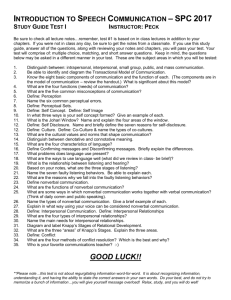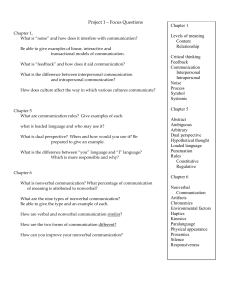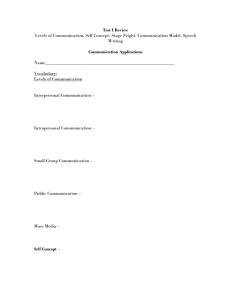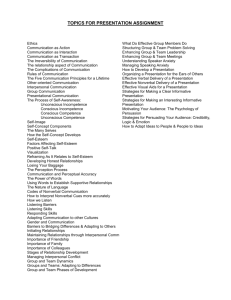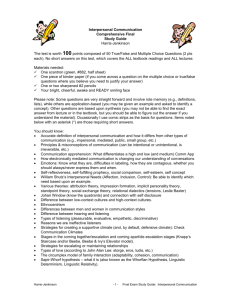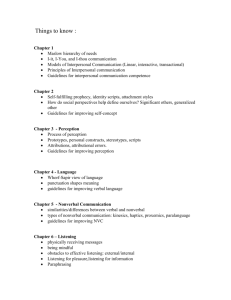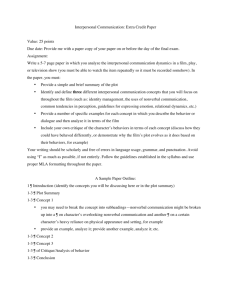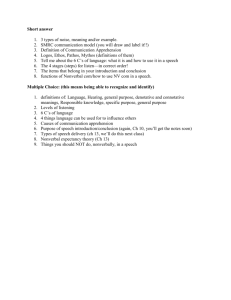Final paper MALC629 Interpersonal Communications Within
advertisement
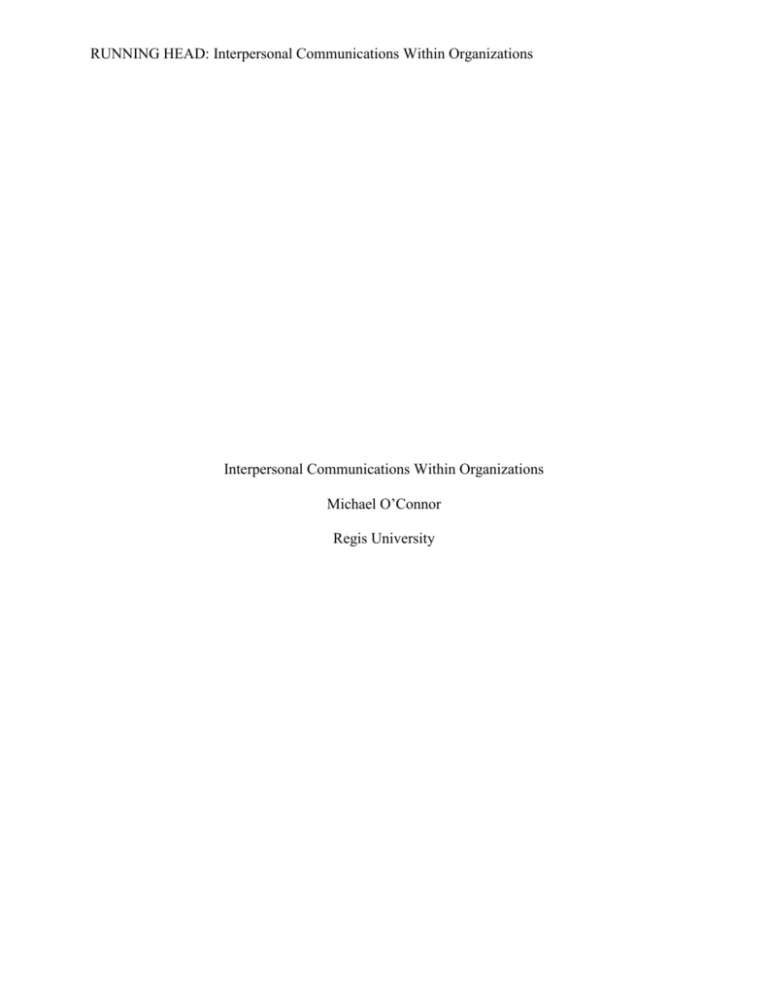
RUNNING HEAD: Interpersonal Communications Within Organizations Interpersonal Communications Within Organizations Michael O’Connor Regis University Interpersonal Communications Within Organizations Interpersonal Communications Within Organizations The methods of communications within an organization can have profound effect and influence on its members. The shared frame of reference needed for all to be on the same page depends on who is sending the information and who is receiving the information. A great deal depends upon the meanings we attach to our words; the messages we send with our nonverbal communications and the style of communication we choose to relay the information. This paper explores two areas of interpersonal communication and how they affect groups or organizations. First, I will explore how a group’s perception of a communication and how they process that information can often affected the desired outcome. Then I will examine nonverbal communication and the many codes use to define it. Perception and Information Processing In our ever increasing technology driven and information download communications there is a increasing need for individuals to understand and be aware of their perception and how they process all forms of communications around them. Hanneman (1975) states that, “we are living in an environment increasingly saturated with information. A large part of our activities deals with decoding information and trying to handle potential information overload. Most of us deal with information overload in unhealthy ways-we either escape from it, take it home with us, or generally ignore it”(p. 41). Within an organization the way individuals make sense of, or Interpersonal Communications Within Organizations decode the information being presented can lead to misunderstanding. This misunderstanding is mostly due to how we each interpret the information according to our frame of reference. The overload of information has exponentially increased since Hanneman (1975) made his observations. An example of the saturation of information and how members of an organization process information through their own lens occurred with the teaching staff at my school. Because of my position as the technology teacher at my school I was appointed the task of school assessment leader (SAL). This position involves all the online computer based assessments that are required by the district. They are given throughout the school year for reading, math and writing. This is on top of the state required TCAP testing and a few other assessments. In my role as SAL I have to coordinate and disseminate a lot of information to the classroom teachers. This is done through group meetings, handouts and emails. This was my first year at this position and I was amazed at how many of the teachers interpreted the same information differently or not at all. On several occasions I had emailed about up coming testing dates and deadlines to all the teachers. I felt I was clear and precise in my communications but quickly found out that many teachers had totally misunderstood and in some cases ignored my communications. Clearly the encoding, how I presented information, and decoding, interpretation by the teachers, did not happen simultaneously. I found out by talking individually with many of the teachers that some had become overwhelmed by the overload of information from the district and school. What I thought was clear and understandable in my emails was just more of the same unwelcomed stream of information that was being piled on them daily. Hanneman (1975) states, “ Once we have selectively processed or decoded the incoming Interpersonal Communications Within Organizations information, we start interpreting the information according to our frame of reference. Based on interpretation, and the amount of prior meaning we have for the event, we evoke a response”(p. 39). In my attempt to evoke a different response to my emails I started to reduce the amount of information in each message and used bulleted lists with colors to highlight important dates and deadline. I was amazed at the response of how the teachers started to process my emails. I had a couple of teachers thank me for making the information understandable at a glance. Verbal Meets Nonverbal Communication In our 21st century society the use of verbal communications is often taken for granted. We start off our lives being taught how to speak, listen, read and write to communicate with others. Our cultures and societies revolve around the spoken and written word. No matter where you live or travel, the use of written or spoken words dominates how we communicate with one another. But there is something else that accompanies this dominating verbal communication, it is the “ vast domain of nonverbal communication: gestures, pictures, graphics, facial expressions, body movement and postures, the symbolic use of clothing and artifacts, the use of time and space” (Harrison & Crouch, 1975). And in most situations of communication, nonverbal is as important or more so than the verbal. There are multiple nonverbal codes that come into play anytime individuals or organizations interact with others. Harrison & Crouch (1975) categorized these nonverbal codes into four categories; Performance codes that are produced with the body, Artifacutual codes that involve the manipulation of objects, Mediatory codes that involve the use of media, and Spatio-temporal codes that occur with the use of time and space. Interpersonal Communications Within Organizations An example of the use of multiple nonverbal codes occurred during a community meeting at my school towards the end of the school year. The administration of DPS wanted to relay some important and school changing information to the parents and students of Ashley Elementary. They decided to do this by scheduling a community meeting after school on a Thursday night. This meeting was being run by the district’s Community Relations Department. A group of people employed by the district to disseminate the administrations policies and information. Close to several hundred parents, students and teachers attended the meeting filling the auditorium and hallways. The Community Relations people had setup two projection screens on the stage with projectors, added their own sound system on large poles on either side of the stage, even though the auditorium had its own projector and sound system. They had a welcome message projecting onto the screens as people came into the meeting and took seats. There were also large posters on the sidewalls of the auditorium with directions on how to text questions to the presenters during the meeting. These were the first of the nonverbal communication codes, Mediatory, use of media and Artifactual, manipulation of objects, employed during this meeting. As the meeting got underway the presenters introduced themselves. There was a team of fivecommunity relation’s people along with an administrator. The lead presenter in an effort to assure the parents that they wanted to hear their questions and opinions repeated it several times to the point that you felt she didn’t really mean it mostly because of her body posture and voice inflection. I was sitting in the middle of the auditorium with parents all around me and from the start of the meeting I could feel an underlining buzz of energy caused by the nonverbal communication that the community relations people were presenting. Interpersonal Communications Within Organizations As the meeting continued charts and colored graphs were projected onto the screens that were use to emphasize the information that was being presented to the parents. The parents were being told that their school was not performing and was in the red or failing category in the states TCAP tests. The presenters continued to refer to the graphs being projected, which could only be clearly seen if you were standing next to them. When parents questioned the charts and the fact they could not be read in the audience the presenters’ nonverbal communications became more obvious. They used nonverbal Performance codes by gesturing with their hands and bodies hoping that would compensate for not being able to read the graphs. At one point in the meeting the administrator from DPS was addressing the parents and had managed to upset a majority of the parents not so much by what she said but how she was communicating nonverbally to the parents, arms were crossed, facial gestures and body posture all gave a different message. As the meeting spiraled out of control the community relations’ team decided it was time to end the meeting because they had come to the designated stopping time. The nonverbal Spatio-temporal code was brought into play signaling to the parents that they were not important enough to continue this meeting. Many parents became enraged and demanded the meeting continue and that their questions be answered. Harrison and Crouch (1975) stated that, “it is apparent that the scope and impact of nonverbal communication is enormous. Paradoxically, our awareness of nonverbal communication is frequently at a low level; we sometimes are least aware of that which is most important” (p. 77). The Community Relations could have used some better nonverbal communication methods the night of this meeting but then again it was a uniting point for the parents at my school and the district has since backed away from closing our school and is allowing the teachers and parents to develop an innovation school plan to address the failing state scores. Interpersonal Communications Within Organizations Conclusion Our society is be constantly being saturated with information mostly in written and spoken forms. With the increasing ability of technology to put us in constant communication with the world around us our ability to process this flow of information is tested daily. How people perceive, or make sense out of all this stimuli in the environment depends on their ability to decode it from their frame of reference. A great deal of time is spent on interpersonal communication in organizations to make sure that written and spoken communications are understandable. All to often people are overwhelmed with these communications and start to ignore or block them. The area of nonverbal communications is often over looked and misunderstood even by professionals. It is the underling current in all interpersonal communication that requires concerted effort to understand and be aware of. Interpersonal Communications Within Organizations References Hanneman, G. (1975). “The study of human communication” in G. Hanneman & W. McEwen (Eds.) Communication and Behavior (pp. 21-46). Reading, Mass: AddisonWesley. Harrison, R. and Crouch, W. (1975). “Nonverbal communication: Theory and research.” In Hanneman and McEwen (Eds.) Communication and research. (pp. 75-96). Reading, MA: Addison-Wesley. Tannen, D. (1994). “Sorry, I’m not apologizing: Conversational rituals between women and men at work.” In Talking from 9 to 5: How women’s and men’s conversational styles affect who gets heard, who gets credit, and what gets done at work. New York: William Morrow.


